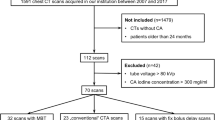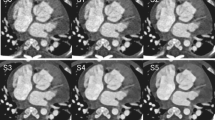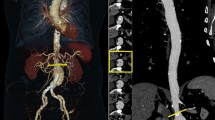Abstract
Background
Several recent studies showed the optimal contrast enhancement with a low-concentration and iso-osmolar contrast media in both adult and pediatric patients. However, low contrast media concentrations are not routinely used due to concerns of suboptimal enhancement of cardiac structures and small vessels.
Objective
To evaluate the feasibility of using iso-osmolar contrast media containing a low iodine dose for CT cardiac angiography at 80 kilovolts (kVp) in neonates and infants.
Materials and methods
The iodixanol 270 group consisted of 79 CT scans and the iopromide 370 group of 62 CT scans in patients ≤1 year old. Objective measurement of the contrast enhancement was analyzed and contrast-to-noise ratios of the ascending aorta and left ventricle were calculated. Regarding subjective measurement, a four-point scale system was devised to evaluate degrees of contrast enhancement, image noise, motion artifact and overall image quality of each image set. Reader performance for correctly differentiating iodixanol 270 and iopromide 370 by visual assessment was evaluated.
Results
Group objective and subjective measurements were nonsignificantly different. Overall sensitivity, specificity and diagnostic accuracy for correctly differentiating iodixanol 270 and iopromide 370 by visual assessment were 42.8%, 59%, and 50%, respectively.
Conclusion
The application of iodixanol 270 achieved optimal enhancement for performing pediatric cardiac CT angiography at 80 kVp in neonates and infants. Objective measurements of contrast enhancement and subjective image quality assessments were not statistically different in the iodixanol 270 and iopromide 370 groups.


Similar content being viewed by others
References
American College of Radiology (2015) ACR manual on contrast media, Version 10.1
Bae KT (2010) Intravenous contrast medium administration and scan timing at CT: considerations and approaches. Radiology 256:32–61
Fleischmann D (2005) How to design injection protocols for multiple detector-row CT angiography (MDCTA). Eur Radiol 15:E60–E65
Fleischmann D (2003) Use of high concentration contrast media: principles and rationale—vascular district. Eur J Radiol 45:S88–S93
Coley BD (2013) Caffey’s pediatric diagnostic imaging. Elsevier Health Sciences, Philadelphia
Zheng M, Wu Y, Wei M et al (2015) Low-concentration contrast medium for 128-slice dual-source CT coronary angiography at a very low radiation dose using prospectively ECG-triggered high-pitch spiral acquisition. Acad Radiol 22:195–202
Pan Y-N, Li A-J, Chen X-M et al (2016) Coronary computed tomographic angiography at low concentration of contrast agent and low tube voltage in patients with obesity: a feasibility study. Acad Radiol 23:438–445
Lee FT Jr, Caroline DF, Thornbury JR et al (1996) A randomized comparison of iodixanol and iohexol in adult body computed tomography scanning. Acad Radiol 3:S500–S506
Zo’o M, Hoermann M, Balassy C et al (2011) Renal safety in pediatric imaging: randomized, double-blind phase IV clinical trial of iobitridol 300 versus iodixanol 270 in multidetector CT. Pediatr Radiol 41:1393–1400
Manke C, Marcus C, Page A et al (2003) Pain in femoral arteriography: a double-blind, randomized, clinical study comparing safety and efficacy of the iso-osmolar iodixanol 270 mgI/ml and the low-osmolar iomeprol 300 mgI/ml in 9 European centers. Acta Radiol 44:590–596
Aspelin P, Aubry P, Fransson SG et al (2003) Nephrotoxic effects in high-risk patients undergoing angiography. N Engl J Med 348:491–499
Deak PD, Smal Y, Kalender WA (2010) Multisection CT protocols: sex- and age-specific conversion factors used to determine effective dose from dose-length product. Radiology 257:158–166
Shuman WP, Branch KR, May JM et al (2008) Prospective versus retrospective ECG gating for 64-detector CT of the coronary arteries: comparison of image quality and patient radiation dose. Radiology 248:431–437
Ramos-Duran LR, Kalafut JF, Hanley M et al (2010) Current contrast media delivery strategies for cardiac and pulmonary multidetector-row computed tomography angiography. J Thorac Imaging 25:270–277
Loubeyre P, Debaro I, Nemoz C et al (2000) Using thoracic helical CT to assess iodine concentration in a small volume of nonionic contrast medium during vascular opacification. AJR Am J Roentgenol 174:783–787
Schoellnast H, Deutschmann HA, Fritz GA et al (2005) MDCT angiography of the pulmonary arteries: influence of iodine flow concentration on vessel attenuation and visualization. AJR Am J Roentgenol 184:1935–1939
Cademartiri F, Mollet NR, van der Lugt A et al (2005) Intravenous contrast material administration at helical 16–detector row CT coronary angiography: effect of iodine concentration on vascular attenuation. Radiology 236:661–665
Faggioni L, Neri E, Sbragia P et al (2012) 80-kV pulmonary CT angiography with 40 mL of iodinated contrast material in lean patients: comparison of vascular enhancement with iodixanol (320 mg I/mL) and iomeprol (400 mg I/mL). AJR Am J Roentgenol 199:1220–1225
Wang H, Xu L, Zhang N et al (2014) Coronary computed tomographic angiography in coronary artery bypass grafts: comparison between low-concentration iodixanol 270 and iohexol 350. J Comput Assist Tomogr 39:112–118
Becker CR, Hong C, Knez A et al (2003) Optimal contrast application for cardiac 4-detector-row computed tomography. Invest Radiol 38:690–694
Zhang WL, Li M, Zhang B et al (2013) CT angiography of the head-and-neck vessels acquired with low tube voltage, low iodine, and iterative image reconstruction: clinical evaluation of radiation dose and image quality. PLoS One 8, e81486
Tricarico F, Hlavacek AM, Schoepf UJ et al (2013) Cardiovascular CT angiography in neonates and children: image quality and potential for radiation dose reduction with iterative image reconstruction techniques. Eur Radiol 23:1306–1315
Schueller-Weidekamm C, Schaefer-Prokop CM, Weber M et al (2006) CT angiography of pulmonary arteries to detect pulmonary embolism: improvement of vascular enhancement with low kilovoltage settings. Radiology 241:899–907
Frush DP, Herlong JR (2004) Pediatric thoracic CT angiography. Pediatr Radiol 35:11–25
Mahesh M (2009) MDCT physics: the basics: technology, image quality and radiation dose. Lippincott Williams & Wilkins, Philadelphia
Holmquist F, Hansson K, Pasquariello F et al (2009) Minimizing contrast medium doses to diagnose pulmonary embolism with 80-kVp multidetector computed tomography in azotemic patients. Acta Radiol 50:181–193
Szucs-Farkas Z, Schaller C, Bensler S et al (2009) Detection of pulmonary emboli with CT angiography at reduced radiation exposure and contrast material volume: comparison of 80 kVp and 120 kVp protocols in a matched cohort. Invest Radiol 44:793–799
Nyman U, Almén T, Aspelin P et al (2005) Contrast-medium-induced nephropathy correlated to the ratio between dose in gram iodine and estimated GFR in ml/min. Acta Radiol 46:830–842
Hernandez F, Mora L, Garcia-Tejada J et al (2009) Comparison of iodixanol and ioversol for the prevention of contrast-induced nephropathy in diabetic patients after coronary angiography or angioplasty. Rev Esp Cardiol 62:1373–1380
Jo SH, Youn TJ, Koo BK et al (2006) Renal toxicity evaluation and comparison between visipaque (iodixanol) and hexabrix (ioxaglate) in patients with renal insufficiency undergoing coronary angiography: the RECOVER study: a randomized controlled trial. J Am Coll Cardiol 48:924–930
Nguyen SA, Suranyi P, Ravenel JG et al (2008) Iso-osmolality versus low-osmolality iodinated contrast medium at intravenous contrast-enhanced CT: effect on kidney function. Radiology 248:97–105
Shin DH, Choi DJ, Youn TJ et al (2011) Comparison of contrast-induced nephrotoxicity of iodixanol and iopromide in patients with renal insufficiency undergoing coronary angiography. Am J Cardiol 108:189–194
Biondi-Zoccai G, Lotrionte M, Thomsen HS et al (2014) Nephropathy after administration of iso-osmolar and low-osmolar contrast media: evidence from a network meta-analysis. Int J Cardiol 172:375–380
Reed M, Meier P, Tamhane UU et al (2009) The relative renal safety of iodixanol compared with low-osmolar contrast media: a meta-analysis of randomized controlled trials. JACC Cardiovasc Interv 2:645–654
Justesen P, Downes M, Grynne BH et al (1997) Injection-associated pain in femoral arteriography: a European multicenter study comparing safety, tolerability, and efficacy of iodixanol and iopromide. Cardiovasc Intervent Radiol 20:251–256
Sutton AG, Finn P, Grech ED et al (2001) Early and late reactions after the use of iopamidol 340, ioxaglate 320, and iodixanol 320 in cardiac catheterization. Am Heart J 141:677–683
Rubin GD, Lane MJ, Bloch DA et al (1996) Optimization of thoracic spiral CT: effects of iodinated contrast medium concentration. Radiology 201:785–791
Suzuki H, Oshima H, Shiraki N et al (2004) Comparison of two contrast materials with different iodine concentrations in enhancing the density of the aorta, portal vein and liver at multi-detector row CT: a randomized study. Eur Radiol 14:2099–2104
Itoh S, Ikeda M, Achiwa M et al (2005) Multiphase contrast-enhanced CT of the liver with a multislice CT scanner: effects of iodine concentration and delivery rate. Radiat Med 23:61–69
Author information
Authors and Affiliations
Corresponding author
Ethics declarations
Conflicts of interest
None
Rights and permissions
About this article
Cite this article
Hwang, JY., Choo, K.S., Choi, Y.Y. et al. Subjective and objective image differences in pediatric computed tomography cardiac angiography using lower iodine concentration. Pediatr Radiol 47, 701–709 (2017). https://doi.org/10.1007/s00247-017-3795-z
Received:
Revised:
Accepted:
Published:
Issue Date:
DOI: https://doi.org/10.1007/s00247-017-3795-z




